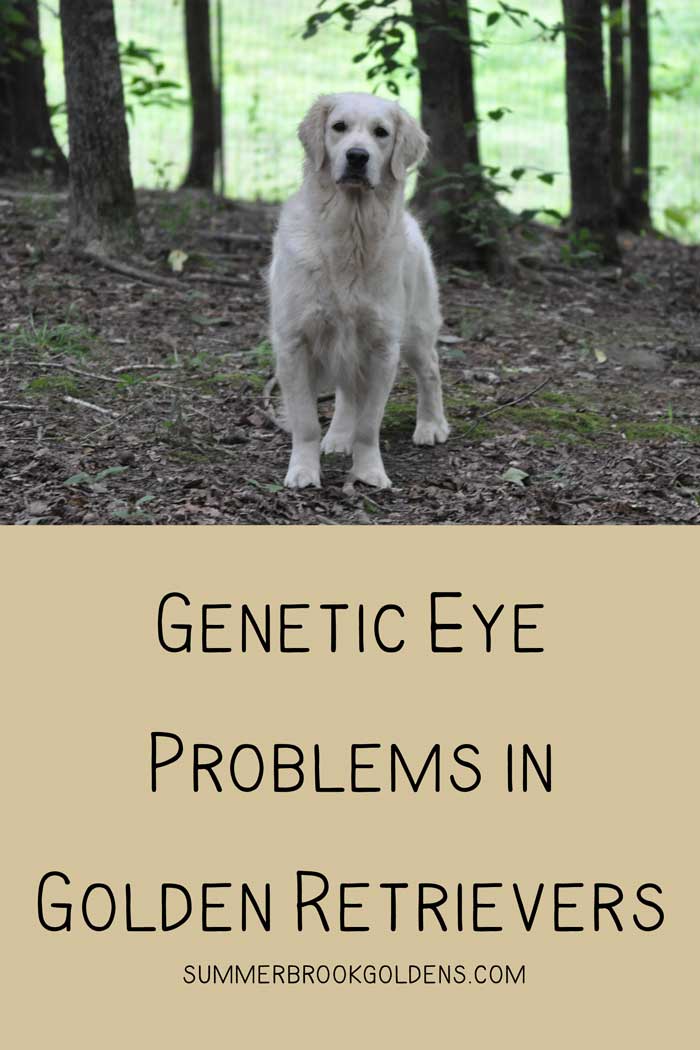Genetic eye problems in Golden Retrievers fall into two categories. The diseases that should be tested for on a yearly basis by a board certified veterinary ophthalmologist is the first category. Those diseases for which there is a DNA test make up the second category.
Yearly OFA Eye Clearances
In order for a dog to get an OFA eye clearance, he/she must be examined by a veterinary ophthalmologist. The ophthalmologist will screen for a wide variety of genetic eye problems.
OFA requires an ophthalmologist to screen for each eye problem listed in the OFA Eyes Certifications. In order to pass OFA eye clearances, a dog must be clear of all the eye conditions on this list . The ophthalmologist then must send the report to OFA.
OFA Database
You can find the results of eye exams on OFA’s database. OFA’s primary function is to evaluate hip and elbow dysplasia and to make these results available to the public. However, they also provide a place for breeders to report to the public eye and cardiac clearances.
DNA Eye Tests for PRA
In recent years, companies have come up with genetic tests for a group of diseases called PRA that causes retinal atrophy. Atrophy of the retina does not normally show up until after a dog is old enough to have been bred. This condition starts off with limited night vision and then progresses to eventual blindness.
Enable Early Detection Before Symptoms Appear
These DNA tests enable a breeder to identify dogs that have this gene before the dog is bred, before the dog ever develops symptoms, or even before an ophthalmologist is able to see evidence of it.
Enable Breeders to Identify Carriers
This test will also enable breeders to identify dogs who are carriers of the disease. With this information, breeders can make sure that every breeding has at least one parent who is clear of these diseases. Breeders should never breed two carriers of a particular disease together. Because the PRA gene is a recessive gene, one clear parent guarantees that none of the puppies will be affected.
Researchers Have Found Different Forms of PRA in English Lines Than American Lines
Not all types of PRA are identifiable with a DNA test, but three of the most common types are: Prcd-PRA, GR-PRA1 and GR-PRA2. Researchers have found one form of PRA in North American lines. They’ve found others in European lines.
Prcd-PRA in American Lines
Prcd-PRA is a form of PRA that researchers found in American and Canadian lines of Golden Retrievers. According to Optigen, the testing organization, all of the Golden Retrievers receiving an “affected” result with this type of PRA are from North America lines. The DNA test for Prcd-PRA became available for use in 2008 and although only about 1% of those Golden Retrievers tested have test results of “affected”, about 25% are carriers of it. If a breeder should breed two carriers together, roughly ¼ of the offspring will be “affected” by it. Because so many American Golden Retreivers are carriers, breeders should test them all.
What Summer Brook Tests For
DNA testing companies developed a test for GR-PRA1 in 2010. Several years later they developed a test for GR-PRA2. These are the most prevalent types of PRA in European lines with it affecting about 5% of Goldens out of European lines. These two types of PRA affect only about .5% of American Golden Retrievers. These two are the types of PRA that we test for at Summer Brook.
Proof of Testing
Since the inception of DNA tests about 10 years ago, a handful of different testing companies have appeared. We at Summer Brook scan in the results of our testing DNA testing to our website. We’ve used several different testing companies. Some have been in Europe. Others have been done in the United States.
DNA Testing is a Tremendous Tool For Breeders That Use Them
The number of Golden Retrievers affected with genetic eye diseases can greatly be reduced if all breeding dogs were screened with the appropriate DNA test for PRA and if breeders would annually have their dogs screened for other genetic eye diseases through CERF. Some affected dogs might go undetected because of a genetic disease not showing up until the dog is past breeding years. However, with good communication between breeders, the offspring of these dogs could be retired before they possibly contribute defective eye genes to the gene pool.
See the following links for further reading on genetic eye diseases.
https://www.grca.org/about-the-breed/health-research/prcd-pra/
http://www.optigen.com/opt9_gr_PRA1.html

See our page on Health Problems in Golden Retrievers for other genetic problems that we test for.

